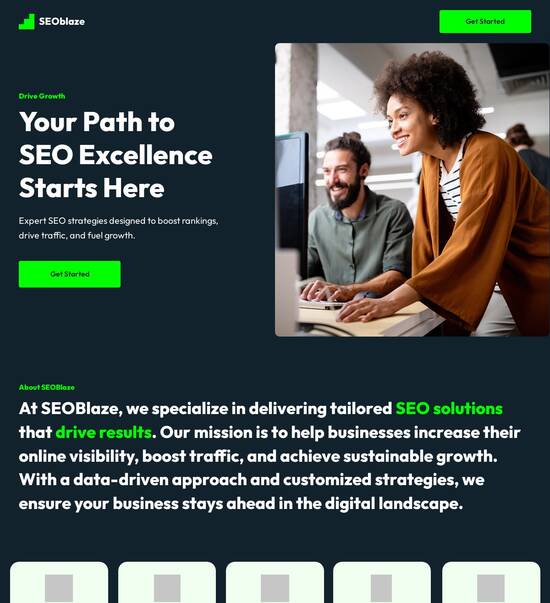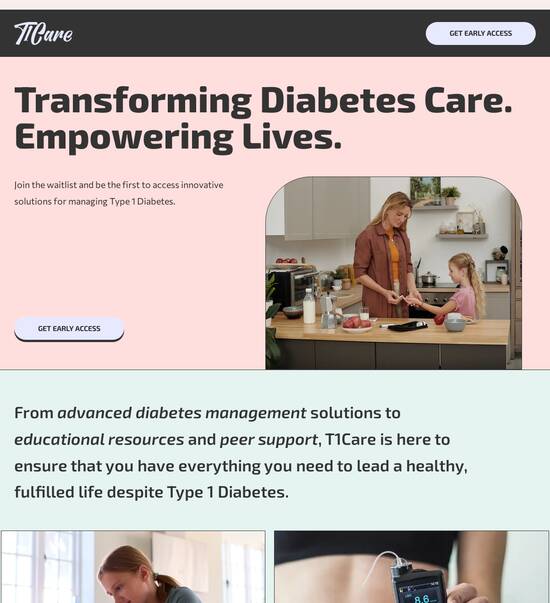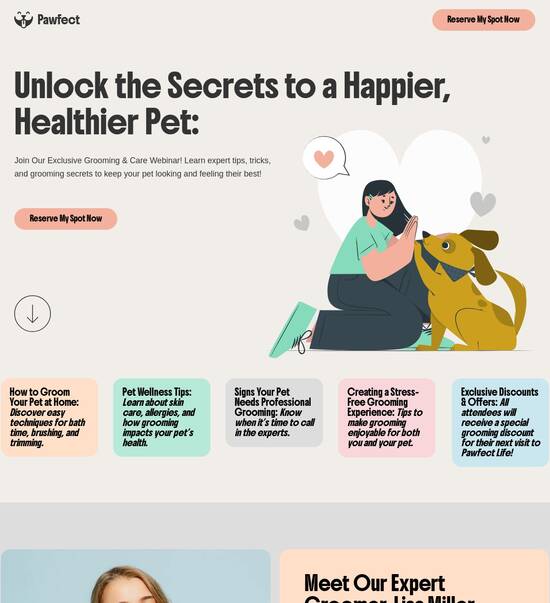
Digital gallery template optimized for Windows desktop
Explore Similar TemplatesAbout template
Instapage digital gallery templates look great and convert on any device, including Windows desktop. Start customizing it now!
Recommended templates

Easy to build without coding
With the intuitive drag-and-drop builder, anyone on your team can create high-converting pages without any knowledge of code or design. Make enhancements to your landing page with custom widgets using Javascript, HTML/CSS, or third-party scripts.

Multiple layouts for any industry and goal
Select from 500+ landing page layouts built to boost conversions across industry-specific scenarios. Customize them by adjusting fonts, adding images, and generating on-brand content with the AI assistant. Quickly scale with Instablocks® and Global Blocks that you can save, reuse, and update globally.

Loads fast and looks polished on any device
Every template is responsive, which means they present professionally on any device and load blazingly fast with our Thor Render Engine. You can also power them up with Google AMP technology to deliver an unparalleled mobile experience and drive higher conversions.

Robust analytics & experimentation
Get real-time updates and reporting across all your devices, showing the number of visitors, conversions, cost-per-visitor, and cost-per-lead. Launch AI-powered experiments, run A/B tests, and use heatmaps to analyze user behavior, then optimize your landing page to maximize conversions.







Easy to build without coding
With the intuitive drag-and-drop builder, anyone on your team can create high-converting pages without any knowledge of code or design. Make enhancements to your landing page with custom widgets using Javascript, HTML/CSS, or third-party scripts.
Multiple layouts for any industry and goal
Select from 500+ landing page layouts built to boost conversions across industry-specific scenarios. Customize them by adjusting fonts, adding images, and generating on-brand content with the AI assistant. Quickly scale with Instablocks® and Global Blocks that you can save, reuse, and update globally.
Loads fast and looks polished on any device
Every template is responsive, which means they present professionally on any device and load blazingly fast with our Thor Render Engine.
Robust analytics & experimentation
Get real-time updates and reporting across all your devices, showing the number of visitors, conversions, cost-per-visitor, and cost-per-lead. Launch AI-powered experiments, run A/B tests, and use heatmaps to analyze user behavior, then optimize your landing page to maximize conversions.
All the features you need to build lead-generating landing pages
Explore more featuresLearn how to build top-performing landing pages for any goal
FAQs
Leading the way in building high-performing landing pages





Maximize your marketing with Instapage's powerful landing page and CRO platform
Instapage stands at the forefront of landing page creation and conversion rate optimization, designed to help marketing teams in diverse verticals such as education, insurance, and tech/SaaS unlock their campaign potential. Its suite of high-converting templates and intuitive tools ensures that even those on a limited budget can effectively boost their ROI in digital marketing.
Why choose Instapage for landing page creation?
When selecting a landing page platform, marketers should consider ease of use, flexibility, and performance. Instapage excels in all these areas, providing teams with a user-friendly interface and a variety of features that streamline the page creation process. This allows marketers to focus on strategy rather than technical hurdles.
- 100+ high-converting templates: These templates cater to various industries, ensuring that your landing pages are not just visually appealing but are also built for conversions.
- Detailed analytics dashboard: Track key performance metrics and understand your audience's behavior to inform future campaigns.
- Collaboration tools: Easily share pages and receive real-time feedback, speeding up the approval process.
Step 1: Get started with landing page creation
Creating a landing page with Instapage is straightforward. First, choose a template that aligns with your campaign goals. Templates are adaptable to various devices, ensuring optimal displays whether on desktop or mobile.
Step 2: Optimize for conversions
Once your landing page is set up, it’s crucial to optimize it to achieve the highest conversion rate. Here are key practices:
- Implement A/B testing: Test different versions of your landing pages to identify what works best for your audience.
- Utilize heatmaps: Analyze where users are clicking and how they navigate your page to make informed adjustments.
- Personalize content: Use dynamic text replacement to tailor messages based on the traffic source.
Step 3: Analyze and iterate
After launching your landing page, the work is not over. Continue to monitor performance and adjust strategies as necessary. Consider these strategies for continual improvement:
- Review performance metrics regularly: Focus on conversion rates, bounce rates, and user engagement.
- Gather user feedback: Implement surveys or feedback tools to understand user experience.
- Iterate based on insights: Don’t hesitate to make changes based on data to enhance performance.
Embracing a data-driven approach allows marketers to harness the full capacity of their landing pages while leveraging the power of Instapage.
Ready to elevate your digital marketing game? Start using Instapage today for free and discover how easy it is to build and optimize unbeatable landing pages.
People also ask about Digital gallery template optimized for Windows desktop
Digital gallery template optimized for Windows desktop
Understanding the digital art gallery template for Windows desktop
A digital art gallery template tailored for Windows desktop serves as a modern alternative for showcasing artwork. Unlike traditional galleries, which rely on physical space, a digital template enables artists to present their work online, reaching a much wider audience. This shift is especially significant in today's increasingly digital world, where online visibility is crucial for artists' success. As many artists now prefer to create vibrant online representations of their work, digital galleries become not just an exhibition space but a critical promotional tool.
The move to digital galleries allows for an immersive experience, where visitors can explore far more than a physical venue might offer. Artists can integrate multimedia elements, interactive components, and a variety of display options that breathe life into their work. By representing art through a digital gallery template, artists can enhance their storytelling capabilities, drawing audiences deeply into their creative narrative.
A digital art gallery template offers accessibility to a global audience.
Flexibility in design allows artists to tailor their space.
Enhanced features such as viewing statistics and visitor interactions.
Key features of the digital art gallery template
When crafting a digital art gallery template for Windows desktop, certain integral features come to the forefront. Customizable design elements are essential for artists and curators who wish to maintain brand consistency. Every color scheme, font choice, and layout option should allow for personalization. This functionality empowers users to create a unique gallery experience that reflects their artistic identity.
Furthermore, responsive layouts are critical when designing for desktop users. A template that adapts seamlessly not only looks polished but also enhances user experience by ensuring the art is displayed optimally. With various aspect ratios and resolutions in play on Windows devices, a well-optimized template guarantees that the art maintains its integrity across multiple display settings.
Ease of customization for color schemes and layouts.
Responsive designs tailored specifically for Windows desktop.
Integration of interactive components for an engaging viewer experience.
Design elements that enhance user experience
The aesthetics of a digital art gallery template carry significant weight. Thoughtful design elements like color schemes and typography play crucial roles in art presentation. A harmonious blend not only enhances the artwork but also contributes to a unified theme that reflects the artist’s essence. For instance, a minimalist approach might allow vibrant pieces to shine, while a more elaborate setup could match the energy of pop art.
Additionally, incorporating artist branding into the gallery’s design creates a seamless connection between the work and the creator. This could manifest through consistent color choices, logo placement, or even thematic design elements that echo the artist’s style. Establishing such a cohesive visual language fosters recognition and aids in building a loyal following.
User Interface (UI) and User Experience (UX) considerations also cannot be overlooked. Intuitive navigation is vital for visitors to explore artwork effortlessly. Clear pathways and visual hierarchy ensure that viewers not only access what they desire but also discover new pieces along the way. Incorporating accessibility features like adjustable text sizes and voice navigation makes the gallery welcoming to a broader audience.
User-friendly navigation enhances the overall visitor experience.
Color schemes and typography need to complement the artwork.
Accessibility features cater to diverse audience needs.
Optimizing layouts for maximum impact
The layout of artworks significantly influences viewers’ perceptions and engagements. This is where grid layouts come into play. By utilizing a grid system, artists can organize content in an aesthetically pleasing manner while showcasing multiple pieces without overwhelming the user. Grids help maintain balance and clarity, enabling visitors to appreciate each piece individually while also valuing their togetherness.
Several grid layout options can be explored, from symmetrical arrangements to asymmetrical exploration. Each type can be employed to create a different mood or emphasis within the gallery. Moreover, the adaptability of the digital gallery template to various screen sizes ensures it works optimally on Windows desktops as well as other devices. This level of flexibility is critical because it allows users to experience the digital gallery in its fullest form, regardless of how it’s being accessed.
Grids provide organization and visual harmony to the layout.
Asymmetrical layouts can promote creativity and exploration.
Responsive design ensures an optimal experience across devices.
Component breakdown: essential features of the template
Each component within a digital art gallery template plays its part in creating an enriching experience. Rows and columns are fundamental in structuring the layout, guiding the viewer through the content seamlessly. Properly organized, these elements help in creating a visual flow that draws viewers from one piece of art to the next, fostering deep engagement.
Moreover, integrating interactive components, such as clickable image overlays or artistic descriptions, can significantly enhance visitor interaction. These features allow visitors to dive deeper, offering context and enriching the overall experience. In addition, seamless integration with content management systems (CMS) is vital for artists and gallery owners. This integration should allow for smooth content updates, easy image uploads, and management tools that simplify the artist's journey.
Rows and columns facilitate a well-structured layout.
Interactive components increase engagement and exploration.
CMS integration allows for easy content management and updates.
Enriching visitor experience and engagement
Creating an engaging experience for visitors is paramount in a digital art gallery. Captivating viewer interest can be achieved through curated narratives where artwork placement tells a story. By thoughtfully arranging pieces, artists can invoke emotions and direct the viewer’s experience strategically. It’s essential to utilize space not just as a backdrop, but as a medium for expression.
Interactive features can encourage exploration, such as virtual tours or augmented reality components that allow visitors to visualize art in their own space. These strategies create a multi-layered experience, encouraging viewers to interact with art on different levels. Furthermore, engaging tools such as comment sections or discussion forums can foster community involvement, giving viewers a platform to share their feedback or perspectives.
Curated narratives enhance the storytelling aspect of art presentation.
Interactive features capture viewer interest and promote exploration.
Tools for viewer feedback build a sense of community and engagement.
The SEO landscape for digital galleries
In an evolving digital space, search engine optimization (SEO) is crucial for increasing visibility for digital galleries. Implementing specific SEO strategies tailored for art galleries can greatly enhance traffic. Key tactics include understanding how to utilize relevant keywords effectively to attract targeted visitors. Proper integration of keywords throughout the site, particularly in titles and descriptions, can boost search engine rankings.
Technical SEO elements are equally important within the template. Focusing on image optimization, including size reduction for faster loading times, can vastly improve the viewer experience. Moreover, attending to meta descriptions and alt text ensures that search engines accurately assess the content, allowing potential visitors to discover the gallery easily.
Implementing SEO strategies increases organic traffic.
Image optimization contributes to overall site performance.
Effective use of meta descriptions and alt text improves search visibility.
Use cases: how various users benefit from the template
Digital art gallery templates provide diverse benefits to different users. For individual artists, having a personal digital gallery is invaluable for personal branding and promotion. It allows them to display their work in a curated way while simultaneously gaining insights into audience preferences, making their future offerings more aligned with what resonates with viewers.
Art collectives and galleries gain significant value from having a digital presence as well. Hosting virtual exhibitions is an excellent opportunity to connect with both local and global art enthusiasts without the constraints of physical space. The logistics of these online exhibitions can be managed efficiently through the right template features, while engagement strategies are crucial to ensuring visitors not only enjoy the exhibits but also participate actively.
Individual artists can enhance personal branding through a digital gallery.
Art collectives can host virtual exhibitions and expand their reach.
Engagement strategies foster community connection and interaction.
Future trends in digital art presentation
The evolution of digital galleries is continuously unfolding. As technology advances, predictions about upcoming features and integrations become essential for forward-thinking artists and gallery owners. Emerging developments could include enhanced virtual reality (VR) and augmented reality (AR) applications, which will allow viewers to interact with art in immersive ways. The possibilities are exciting and aim to captivate audiences on new levels.
Furthermore, the growing importance of analytics can’t be ignored in understanding visitor behavior. Capturing visitor data provides invaluable insights that can refine the gallery experience. Understanding how viewers interact with specific artworks can inform future exhibitions and strategies, allowing gallery owners to cater to preferences more closely.
Virtual and augmented reality technologies offer immersive viewer experiences.
Visitor data analytics help refine gallery presentations.
Predictions of future trends guide digital gallery development.
Crafting a distinctive digital presence
Developing marketing strategies is critical for art galleries looking to enhance their digital presence. Leveraging blogs and newsletters can keep audiences informed and engaged with upcoming exhibitions, artist profiles, and more. Involving existing viewers by offering them exclusive content or previews enhances their connection with the gallery, making them less likely to wander to other platforms.
Collaborating with influencers within the art community serves as a strategic entry point for reaching wider audiences. Combining efforts can enhance visibility, creating an opportunity for more interactions. Additionally, gathering and analyzing user feedback after exhibitions offers insights that can lead to continuous improvement in the digital gallery experience.
Leveraging blogs and newsletters maintains audience engagement.
Collaborating with influencers expands audience reach.
User feedback drives continuous improvement in gallery operations.
Conclusion: pioneering a new path for art presentation
Digital galleries present an innovative approach to art presentation, allowing for broader appreciation of artistic work. They offer unique advantages for both emerging and established artists, paving the way toward greater accessibility in the arts. The evolution of these platforms highlights the integration of technology and creativity, reshaping the art landscape.
As digital galleries continue to grow in popularity, they will undoubtedly enrich the experience of viewing art. They represent a shift towards inclusivity, ensuring that art remains accessible to diverse audiences, encouraging appreciation and engagement across geographical boundaries.
Ready to skyrocket conversions?
Supercharge your ad campaigns with high-performing landing pages
Get started














